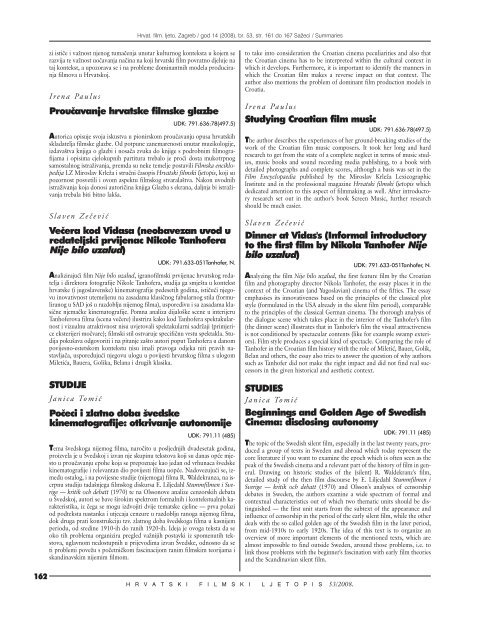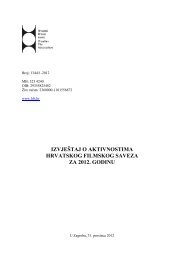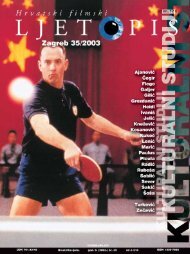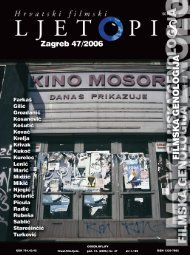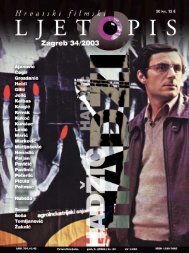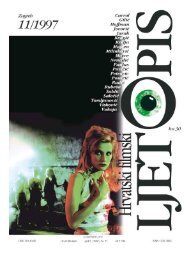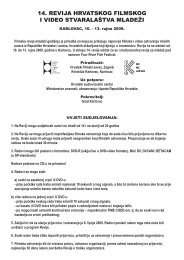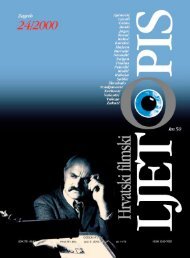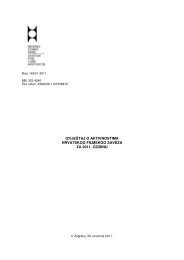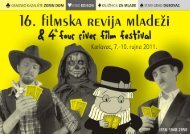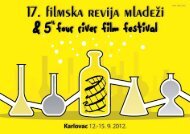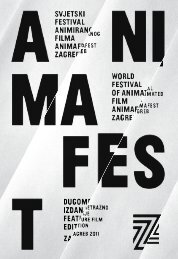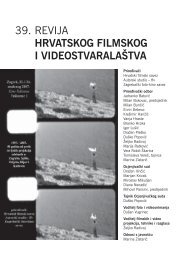Create successful ePaper yourself
Turn your PDF publications into a flip-book with our unique Google optimized e-Paper software.
hfl_<strong>53</strong>.qxp <strong>2008</strong>-04-18 11:08 Page 162<br />
Hrvat. film. ljeto, Zagreb / god 14 (<strong>2008</strong>), br. <strong>53</strong>, str. 161 do 167 Sa`eci / Summaries<br />
zi isti~e i va`nost njenog tuma~enja unutar kulturnog konteksta u kojem se<br />
razvija te va`nost uo~avanja na~ina na koji hrvatski film povratno djeluje na<br />
taj kontekst, a upozorava se i na probleme dominantnih modela produciranja<br />
filmova u Hrvatskoj.<br />
Irena Paulus<br />
Prou~avanje hrvatske filmske glazbe<br />
UDK: 791.636:78(497.5)<br />
Autorica opisuje svoja iskustva u pionirskom prou~avanju opusa hrvatskih<br />
skladatelja filmske glazbe. Od potpune zanemarenosti unutar muzikologije,<br />
izdava{tva knjiga o glazbi i nosa~a zvuka do knjige s podrobnim filmografijama<br />
i opisima cjelokupnih partitura trebalo je pro}i dosta mukotrpnog<br />
samostalnog istra`ivanja, premda su neke temelje postavili Filmska enciklopedija<br />
LZ Miroslav Krle`a i stru~ni ~asopis Hrvatski filmski ljetopis, koji su<br />
pozornost posvetili i ovom aspektu filmskog stvarala{tva. Nakon uvodnih<br />
istra`ivanja koja donosi autori~ina knjiga Glazba s ekrana, daljnja bi istra`ivanja<br />
trebala biti bitno lak{a.<br />
Slaven Ze~evi}<br />
Ve~era kod Vidasa (neobavezan uvod u<br />
redateljski prvijenac Nikole Tanhofera<br />
Nije bilo uzalud)<br />
UDK: 791.633-051Tanhofer, N.<br />
Analiziraju}i film Nije bilo uzalud, igranofilmski prvijenac hrvatskog redatelja<br />
i direktora fotografije Nikole Tanhofera, studija ga smje{ta u kontekst<br />
hrvatske (i jugoslavenske) kinematografije pedesetih godina, isti~u}i njegovu<br />
inovativnost utemeljenu na zasadama klasi~nog fabularnog stila (formuliranog<br />
u SAD jo{ u razdoblju nijemog filma), usporedivu i sa zasadama klasi~ne<br />
njema~ke kinematografije. Pomna analiza dijalo{ke scene u interijeru<br />
Tanhoferova filma (scena ve~ere) ilustrira kako kod Tanhofera spektakularnost<br />
i vizualnu atraktivnost nisu uvjetovali spektakularni sadr`aji (primjerice<br />
eksterijeri mo~vare); filmski stil ostvaruje specifi~nu vrstu spektakla. Studija<br />
poku{ava odgovoriti i na pitanje za{to autori poput Tanhofera u danom<br />
povijesno-estetskom kontekstu nisu imali pravoga odjeka niti pravih nastavlja~a,<br />
uspore|uju}i njegovu ulogu u povijesti hrvatskog filma s ulogom<br />
Mileti}a, Bauera, Golika, Belana i drugih klasika.<br />
STUDIJE<br />
Janica Tomi}<br />
Po~eci i zlatno doba {vedske<br />
kinematografije: otkrivanje autonomije<br />
UDK: 791.11 (485)<br />
Tema {vedskoga nijemog filma, naro~ito u posljednjih dvadesetak godina,<br />
proizvela je u [vedskoj i izvan nje skupinu tekstova koji su danas op}e mjesto<br />
u prou~avanju epohe koja se prepoznaje kao jedan od vrhunaca {vedske<br />
kinematografije i relevantan dio povijesti filma uop}e. Nadovezuju}i se, izme|u<br />
ostalog, i na povijesne studije (nijemoga) filma R. Waldekranza, na iscrpnu<br />
studiju tada{njega filmskog diskursa E. Liljedahl Stummfilmen i Sverige<br />
— kritik och debatt (1970) te na Olssonove analize cenzorskih debata<br />
u [vedskoj, autori se bave {irokim spektrom formalnih i kontekstualnih karakteristika,<br />
iz ~ega se mogu izdvojiti dvije tematske cjeline — prva polazi<br />
od podteksta nastanka i utjecaja cenzure u razdoblju ranoga nijemog filma,<br />
dok druga prati konstrukciju tzv. zlatnog doba {vedskoga filma u kasnijem<br />
periodu, od sredine 1910-ih do ranih 1920-ih. Ideja je ovoga teksta da se<br />
oko tih problema organizira pregled va`nijih postavki iz spomenutih tekstova,<br />
uglavnom nedostupnih u prijevodima izvan [vedske, odnosno da se<br />
ti problemi pove`u s po~etni~kom fascinacijom ranim filmskim teorijama i<br />
skandinavskim nijemim filmom.<br />
to take into consideration the Croatian cinema peculiarities and also that<br />
the Croatian cinema has to be interpreted within the cultural context in<br />
which it develops. Furthermore, it is important to identify the manners in<br />
which the Croatian film makes a reverse impact on that context. The<br />
author also mentions the problem of dominant film production models in<br />
Croatia.<br />
Irena Paulus<br />
Studying Croatian film music<br />
UDK: 791.636:78(497.5)<br />
The author describes the experiences of her ground-breaking studies of the<br />
work of the Croatian film music composers. It took her long and hard<br />
research to get from the state of a complete neglect in terms of music studies,<br />
music books and sound recording media publishing, to a book with<br />
detailed photographs and complete scores, although a basis was set in the<br />
Film Encyclopaedia published by the Miroslav Krle`a Lexicographic<br />
Institute and in the professional magazine Hrvatski filmski ljetopis which<br />
dedicated attention to this aspect of filmmaking as well. After introductory<br />
research set out in the author's book Screen Music, further research<br />
should be much easier.<br />
Slaven Ze~evi}<br />
Dinner at Vidas's (Informal introductory<br />
to the first film by Nikola Tanhofer Nije<br />
bilo uzalud)<br />
UDK: 791.633-051Tanhofer, N.<br />
Analyzing the film Nije bilo uzalud, the first feature film by the Croatian<br />
film and photography director Nikola Tanhofer, the essay places it in the<br />
context of the Croatian (and Yugoslavian) cinema of the fifties. The essay<br />
emphasises its innovativeness based on the principles of the classical plot<br />
style (formulated in the USA already in the silent film period), comparable<br />
to the principles of the classical German cinema. The thorough analysis of<br />
the dialogue scene which takes place in the interior of the Tanhofer's film<br />
(the dinner scene) illustrates that in Tanhofer's film the visual attractiveness<br />
is not conditioned by spectacular contents (like for example swamp exteriors).<br />
Film style produces a special kind of spectacle. Comparing the role of<br />
Tanhofer in the Croatian film history with the role of Mileti}, Bauer, Golik,<br />
Belan and others, the essay also tries to answer the question of why authors<br />
such as Tanhofer did not make the right impact and did not find real successors<br />
in the given historical and aesthetic context.<br />
STUDIES<br />
Janica Tomi}<br />
Beginnings and Golden Age of Swedish<br />
Cinema: disclosing autonomy<br />
UDK: 791.11 (485)<br />
The topic of the Swedish silent film, especially in the last twenty years, produced<br />
a group of texts in Sweden and abroad which today represent the<br />
core literature if you want to examine the epoch which is often seen as the<br />
peak of the Swedish cinema and a relevant part of the history of film in general.<br />
Drawing on historic studies of the (silent) R. Waldekranz's film,<br />
detailed study of the then film discourse by E. Liljedahl Stummfilmen i<br />
Sverige — kritik och debatt (1970) and Olsson's analyses of censorship<br />
debates in Sweden, the authors examine a wide spectrum of formal and<br />
contextual characteristics out of which two thematic units should be distinguished<br />
— the first unit starts from the subtext of the appearance and<br />
influence of censorship in the period of the early silent film, while the other<br />
deals with the so called golden age of the Swedish film in the later period,<br />
from mid-1910s to early 1920s. The idea of this text is to organize an<br />
overview of more important elements of the mentioned texts, which are<br />
almost impossible to find outside Sweden, around those problems, i.e. to<br />
link those problems with the beginner's fascination with early film theories<br />
and the Scandinavian silent film.<br />
162<br />
H R V A T S K I F I L M S K I L J E T O P I S <strong>53</strong>/<strong>2008</strong>.


